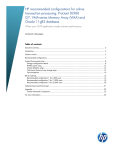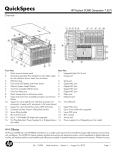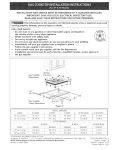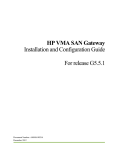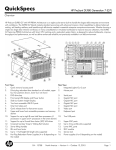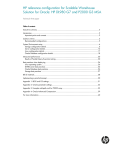Download Car Solutions QPI-G7-MAIN-V2.0 Installation guide
Transcript
Technical white paper HP recommended configurations for online transaction processing: ProLiant DL980 G7, VMA-series Memory Array (VMA) and Oracle 11gR2 database When your OLTP application needs extreme performance Table of contents Executive summary 2 Introduction 3 Solution criteria 3 Recommended configurations 6 System/Environment setup Storage configuration details DL980 system setup Oracle database setup VMA-series Memory Array storage setup Test assumptions 8 8 12 13 Bill of materials Recommended configuration 1 for 6,000 users Recommended configuration 2 for 13,000 users Recommended configuration 3 for 26,000 users 15 Implementing a proof-of-concept 20 Appendix Oracle Advanced Compression 21 21 For more information 22 13 14 15 17 19 Executive summary The HP High Performance Solution for Oracle databases is optimized for HP ProLiant DL980 servers and HP VMA-series Memory Arrays as a common foundation that delivers flexibility and choice. If you are looking for better performance and the lower cost of an ‘appliance-like’ solution that provides a common foundation yet delivers flexibility with choice of OS and database versions then the HP High Performance Solution for Oracle is the solution for you. The objective of the proposed configurations is to: Provide best-in-class performance – At the heart of the design is the requirement to deliver unapologetic performance capable of providing OLTP transactional performance for the most demanding databases in an enterprise environment. The performance is achieved using HP ProLiant DL980 servers and a SAN of HP VMA-series Memory Arrays (VMAs) utilizing flash storage. You’ll also get the reliability that you need to run your applications with complete confidence, while maintaining data integrity and minimizing downtime. Reduce the risk to implement database solutions – These recommended configurations provide a balance of CPU, memory and I/O capacity specifically optimized for database workloads. As a result, the likelihood of functional or performance problems in your database deployments is drastically reduced. Reduce the time to implement database solutions on HP servers – By using the configuration guidelines described in this document the time to deploy the application database can be reduced. Simplify the purchasing process for well-defined HP server configurations – The recommended configurations may be implemented as is or used as a starting point for a semi-custom configuration. In either case, the expectation is that IT can make quicker and more informed decisions to purchase the optimal configuration for the application. Always a critical part of the IT infrastructure, databases are at the heart of a number of trends in IT: Demand for large symmetric multiprocessing (SMP) type scalability in a Linux or Microsoft® Windows® environment Complex workloads that demand better response times and increased I/O operations per second (IOPS) Applications and data are growing in size and complexity. Many applications and business drivers are demanding lower latencies and increased performance. Organizations are now able to migrate complex solutions from high-cost proprietary systems onto lower-cost Linux or Windows-based systems using a variety of database choices. Organizations are consolidating applications to fewer servers to simplify critical data center operations. Consolidation can reduce cost, power consumption, management complexity, and physical space requirements in the data center. Increasingly outdated, rigid, and costly OLTP systems are being replaced with cost-effective, flexible platforms that can handle complex workloads that demand better response times and deliver increased IOPS to address the growing volume, variety, and velocity of data. Historically, different computer system components have advanced at different relative rates. Although disk capacity has improved somewhat, disk performance ranks at the bottom with no significant improvement compared to million-fold boosts by other system components such as servers. Online transaction processing (OLTP) applications such as enterprise resource planning (ERP), supply chain management (SCM), web-based e-commerce systems as well as extract, transform and load (ETL) applications can benefit from the performance of a scale-up architecture. More importantly, the HP ProLiant DL980 G7 with HP VMA-series Memory Array solution offers the capacity to consolidate and manage these applications in a single server. Any database application that requires increase in performance including lower user response times, higher throughput, and increased IOPS is a candidate for these configurations. The HP High Performance Solution for Oracle is a platform that delivers extreme performing storage, choice of OS and database versions, and is optimized for the HP ProLiant DL980. This white paper describes three recommended configurations to support small, medium and large OLTP solutions, capitalizing on the power of the HP ProLiant DL980 G7 server, HP VMA3210 Memory Array, and using the operating system and database versions of your choice. The objective of these configurations is to meet or exceed the demanding OLTP performance requirements, reduce the time to purchase and implement the solution as well as to minimize any implementation risks. The recommended configurations described in this paper include discussions of the storage configuration, the DL980 setup, the general database setup, the best practices, and a bill of materials. The configuration information is based on data collected in HP’s solution performance lab and proof of concept testing. 2 Target audience: This white paper is intended for system architects and decision makers who have responsibility for evaluating, purchasing, recommending and/or implementing database applications based on Oracle databases. Previous knowledge of Linux, Oracle database software, HP ProLiant servers, and HP VMA-series Memory Array products would be advantageous but is not required. This white paper describes testing performed in October 2010 and May 2011. Introduction The recommended configurations are based on an online transaction processing (OLTP) workload. The set of transactions used in the workload is representative of a web-based application. These transactions allow users to check product availability, place an order for products, pay for their order, view the status of their order, and schedule delivery of their order. The most common transactions are placing and paying for an order; these two transactions occur with similar frequency and occur approximately ten times as frequently as other transactions. Checking for product availability and the status of an order are simple, read-only transactions. Placing an order for products, paying for an order, and scheduling delivery of an order include read and write (Insert, Select, and Update) operations. Placing an order is the most complex transaction, involving multiple tables. The recommendations provided are most accurate for applications with transactions similar to those described above. Also these solutions will perform very well for packaged solutions such as Oracle E-Business Suite, PeopleSoft, Siebel, and SAP. We strongly recommend that you work with your local HP Reseller or HP Sales Representative to determine the best solution for you. Solution criteria Table 1 below shows details of the three workloads in terms of the maximum user count, database size, business transactions/hour, and storage type. These values are the estimated maximum values for the recommended configurations listed in this document. The maximum values are not listed for all possible server configurations. A business transaction has to do with a business function, for example, check status of an order or view an invoice. It is not possible to make a direct comparison between a sustained business transaction volume and transactions per minute (TPM). Business transactions are made up of several individual SQL transactions required to satisfy the business request rather than a total of the individual SQL transactions. Some batch and reporting requirements are essential elements of most OLTP environments. If your environment has extensive batch processing and/or reporting requirements, then HP recommends starting with a proof of concept to test your specific workload before the final configuration is defined. Many other configurations can be created that use additional hardware and support a greater number of transactions. If you need help with a specific Oracle solution or prefer a solution design or sizing based on your requirements please contact your local HP reseller, HP sales representative, or the HP Oracle Solution Center in your region. Table 1. Recommended Configuration metrics and storage type options Number HP ProLiant Server Model User Count Database Size TB Business OLTP Transactions per Hour Storage Type 1 DL980 G7 (4p/32c) 6,000 8 35,000,000 Flash 2 DL980 G7 (4p/40c) 13,000 15 70,000,000 Flash 3 DL980 G7 (8p/80c) 26,000 25 150,000,000 Flash The first configuration using four Intel® Xeon® E7-2830 processors utilizes direct attached storage (DAS) with two HP VMA controllers and Memory Arrays. The second configuration using four Intel Xeon E7-4870 processors utilizes DAS with four HP VMA Memory Arrays and the third configuration uses eight Intel Xeon E7-4870 processors with eight HP VMA Memory Arrays. Additional information on these VMA products can be found in the Storage configuration details section. 3 The tables below list the supported Intel Xeon processors, memory DIMMs, and PCI expansion slots for the ProLiant DL980 G7 server. This information is included to help determine how the recommended configurations can be modified to support different workload sizes or user combinations. Table 2. Supported E7 Family Processors Cores Max Cores in a DL980 G7 E7-4870 (30MB Cache, 2.4GHz, 130W, 6.4 GT/s QPI) 10 80 E7-2860 (24MB Cache, 2.26GHz, 130W, 6.4 GT/s QPI) 10 80 E7-2850 (24MB Cache, 2.00GHz, 130W, 6.4 GT/s QPI) 10 80 E7-2830 (24M Cache, 2.13 GHz, 105W, 6.4 GT/s QPI) 8 64 E7-4807 (18M Cache, 1.86GHz, 95W, 4.8 GT/s QPI ) 6 48 Processor Type Intel Xeon Note: The Intel Xeon processor E7 series supports Hyper-Threading (HT). HT is recommended and was tested in our configurations. However it is good practice to test HT with your particular application. Table 3 shows the memory module kits available for the DL980 G7. The more ranks per DIMM the higher the performance, so quad rank DIMMs perform better than dual rank DIMMs. Performance is best when the installed DIMMs are all of equal size. Table 3. Supported Memory DIMMs Memory Kits Rank HP 4GB 1Rx4 PC3-10600R-9 Single HP 4GB PC3L-10600R-9 512Mx Single HP 8GB 2Rx4 PC3-10600R-9 Dual HP 8GB 2Rx4 PC3L-10600R-9, 512Mx RoHS Dual HP 16GB 2Rx4 PC3L-10600R-9 Dual HP 16GB 4Rx4 PC3-8500R-7 Quad HP 32GB 4R x4 PC3L-8500R-7 Quad PC3L = low voltage memory 4 Table 4 represents the minimum, middle, and maximum memory combinations possible for the 4, 8, 16, and 32 GB memory kits available for the DL980 G7 servers. However, for best performance use dual or quad rank memory DIMMs. Table 4. Minimum, middle, and maximum memory for 4 and 8 processor configurations Number of CPUs Memory Density (GB) Total Memory Cartridges Min Memory (GB) Mid Memory (GB) Max Memory (GB) 4 4 8 64 128 256 4 8 8 128 256 512 4 16 8 256 512 1024 4 32 8 512 1024 2048 8 4 16 128 256 512 8 8 16 256 512 1024 8 16 16 512 1024 2048 8 32 16 1024 2048 4096 Note: Max memory depends on the number of processors configured. Four/eight processor configurations support up to 2TB/4TB of memory, respectively. However Linux 2.6.18 Kernel only supports up to 1TB. The Linux 2.6.32 Kernel expands memory support to 2TB memory or higher based on the Linux implementation. Windows Server 2008 supports up to 2TB currently. Table 5. VMA supported Expansion Slot Configurations Expansion Slots Standard Main I/O with 5 Gen2 slots: (3) x4 PCI-Express; (2) x8 PCI-Express PCIe Option with 6 slots: (1) x4 Gen1 PCI-Express; (1) x4 Gen2 PCI-Express (4) x8 Gen2 PCI-Express Low Profile Expansion Option with 5 Gen2 slots; (1) x4 PCI-Express; (4) x8 PCI-Express Note: The PCI-X and PCIe Combination Option slots are not to be used for HP VMAseries Memory Arrays. I/O slots capable of bi-directional x8 PCIe provide the best performance. The DL980 G7 server comes with the Standard Main I/O board with PCIe slots 7-11. Slots 9 and 11 are x8 Gen2 PCIe slots. The PCIe expander option provides additional I/O slots 1-6. Slots 2, 3, 5 and 6 are x8 Gen2 PCIe slots. The low profile expansion option provides additional I/O slots 12-16. Slots 12, 13, 15, and 16 are x8 Gen2 PCIe slots. For configuration three, the DL980 with eight VMA arrays requires eight PCIe slots. In order to get the best performance for configurations two and three you will need to also install the low profile expansion option to optimize performance with the PCIe x8 slots. If a VMA Array is ordered with a DL980 G7, PCIe Option I/O Expansion (588137-B21) is integrated regardless. If 3 or more (up to 8) VMA Arrays are ordered with the DL980 G7, the low profile PCIe Option (AM434A) is automatically 5 integrated. Table 6 provides the recommended slot locations occupied by the VMA pass-thru cards for each configuration. Table 6. HP ProLiant DL980 G7 server with HP VMA PCIe slot configurations Configuration Number of HP VMA arrays DL980 PCIe x8 slots needed Recommended PCIe x8 I/O slot # Slot Type 1 2 2 2, 5 x8 Gen2 PCIe 2 4 4 2, 5, 9, 11 x8 Gen2 PCIe 3 8 8 2, 3, 5, 9, 11, 12, 13, 15 x8 Gen2 PCIe If an add-on SAS controller is installed into the DL980 it may be possible the SAS controller could interfere with the performance of any VMA pass-thru cards installed in PCIe x8 slots 9 and 11 on the Standard Main I/O. You may want to move any VMA pass-thru cards to alternate PCIe x8 slots 6 and 16. Note: It is not supported to use slot 1 for any HP VMA PCIe Pass-Thru Cards due to low I/O performance (PCI-x 100 MHz). Recommended configurations The detailed information for these recommended configurations includes the server, number and type of processors, memory, internal and external storage. The configurations were evaluated for a given workload: concurrent users, I/O operations per second, transactions/hour, and database size. The configurations are based on testing done in HP’s performance integration lab to support the implementation of online transaction processing servers using HP ProLiant servers running Red Hat Linux and Oracle 11gR2 Enterprise Edition. The configurations were determined based on the following utilization criteria: CPU utilization of approximately 75% at the target workload Buffer cache hit ratio of no less than 98% (indicating that the majority of the active database buffers are in physical memory) Disk I/O activity reflects a read/write ratio of approximately 80/20 HP ProLiant DL980 G7 server configurations examples: 4 or 8 processors 256 - 1024 GB of memory (4P upgradeable to 1TB) (8P upgradeable to 2TB) 8, 15, and 25 TB database sizes 35 million business trans/hr (6,000 users), 70 million business trans/hr (13,000 users), and 150 million trans/hr (26,000 users) Storage – 2, 4 or 8 VMA3210 Memory Arrays 6 Table 7. HP ProLiant DL980 G7 server configurations Number CPUs CPU Type Memory GB External Storage Users Transactions /hr Database size TB 1 4 Intel Xeon E7-2830 (24M Cache, 2.13 GHz, 105W, 6.4 GT/s QPI) 256 (2) VMA3210 Memory Arrays 6,000 35,000,000 8 2 4 Xeon E7-4870 (30MB Cache, 2.4GHz, 130W, 6.4 GT/s QPI) 512 (4) VMA3210 Memory Arrays 13,000 70,000,000 15 3 8 Xeon E7-4870 (30MB Cache, 2.4GHz, 130W, 6.4 GT/s QPI) 1024 (8) VMA3210 Memory Arrays 26,000 150,000,000 25 Note: Currently this reference solution is supported with Red Hat Enterprise Linux (RHEL) 5.x, SUSE Linux Enterprise Server (SLES) 11 SP1, Oracle Linux (OL) and Oracle Unbreakable Enterprise Kernel (OUEK) 5.x, and Windows Server 2008 R2. Figure 1. HP ProLiant DL980 G7 with eight internal drives and an optical DVD 7 System/Environment setup Storage configuration details Internal storage The DL980 G7 OLTP recommended configurations use four internal drives configured with RAID1 for the OS and 11gR2 software. The server supports up to eight internal drives, so additional drives can be added for staging data, logs, or other requirements. Table 8. Internal storage controllers Database Server Internal Storage Controller HP Smart Array P410i/Zero Memory Controller (RAID 0/1/1+0) DL980 G7 Available upgrades: 512MB with BBWC, Battery kit upgrade (for BBWC), 512MB Flash Backed Write Cache (FBWC), 1G Flash Backed Write Cache, and Smart Array Advanced Pack (SAAP) External storage VMA3210 Memory Array Hewlett Packard’s VMA-series Memory Arrays are external systems offering high capacities of solid state storage, using hot-swappable flash memory devices. The VMA-series Memory Arrays feature rackable external solid state storage in capacities ranging from 5TB to 10TB per Single-level Cell (SLC) array. Multiple arrays can create scalable capacities up to petabytes of solid state storage. The arrays are designed for customers who need low-latency response times, very high I/O performance, and large capacity. Solid state memory technology provides these storage products with no-moving-parts reliability and low power and cooling requirements. These arrays offer a choice of PCIe-direct attach or Fibre Channel SAN attach. PCIedirect attach with rackmount servers offers lowest latency speeds for single-server applications. Fibre Channel SAN attach with either blade or rackmount servers allows multiple servers to operate on the same shared data, with practically unlimited amounts of solid state storage. The VMA3210 Memory Array is a 3U appliance that provides solid state storage to servers. The VMA-series Memory Array eliminates the seek-bound limitations of rotating disk storage and delivers significant application performance benefits over traditional storage systems that utilize hundreds of hard disk drives (HDDs). VMA-series Memory Arrays have practically unlimited scalability – the very large capacities that can be created with VMA-series arrays enable users to place entire databases into solid state memory without needing to architect their solution around limited capacity solid state drives. Using a massively parallel architecture with distributed garbage collection implemented in hardware, each VMA-series Memory Array with Single Layer Cell (SLC) NAND Flash delivers sustained DRAM-like performance that is an order of magnitude faster than a similar size HDD array: 1.4 GB/s bandwidth 350K Random Read IOPS Delivers up to 240K Sustained Random Write IOPS (4K block with RAID) Up to 10TB raw capacity and 6TB Usable flash storage (if configured for best performance) Low latency Flash 4 + 1 parity RAID – Reads: 80 micro seconds – Writes: 25 micro seconds – Non-blocking Erases ensures consistent low-latency Reads Significant application performance 90% reduction in cost, power, and cooling for similar performance Power-safe writes without batteries 8 The configuration used to achieve highest performance consists of attaching the VMA directly to the PCIe slots in the back of the DL980 server using VMA Direct Attach PCIe x8 pass-thru cards. This is the configuration used in the three solutions described in this paper. VMA can also be configured via Fibre Channel via a 2U HP VMA SAN Gateway that provides LUN management functions. A maximum of two VMA memory arrays are supported behind one VMA SAN Gateway for Fibre Channel SAN attach. However, latency will be higher than that achieved with direct attach pass-thru cards. If an active-active highly available solution is required using Oracle Real Application Clusters (RAC) then you could use a combination of the HP VMA SAN Gateway with the VMAs to provide a shared storage configuration. Table 9. DL980 G7 and VMA Storage Performance and Capacity Attribute VMA Configuration 1 VMA Configuration 2 VMA Configuration 3 Number of arrays 2 4 8 Potential IOPS 600,000 1,200,000 2,400,000 Bandwidth (GB/s) 2.8 5.6 11.2 Capacity (RAW) 20TB 40TB 80TB Capacity (Useable) 12TB 24TB 48TB When the active data of large-scale and high performance applications using Oracle databases is assigned to VMA appliances, dramatic application acceleration and much higher CPU utilization is achieved. This enables the data center by supporting high performance random I/O without the need for large DRAM server footprints or thousands of spinning HDDs. Each VMA3210 is populated with 84 x 128GB solid state memory (SSM) Modules based on Single Layer Cell (SLC) flash memory devices. VMA Switched Memory technology and VMA’s Flash RAID provide the system with its industry-leading scalability, data reliability and efficiency: Hot swappable flash memory modules with 4+1 RAID and 4 spares System power: less than 120W per Useable Terabyte Endurance: greater than 8TB Writes per Hour for 5 Years Redundant power supplies and cooling are provided in all VMA-series Memory Array systems. Manageability is built into the system with an onboard management controller. Built-in management processor with command line interface Front panel status icons and internal status LEDs on each memory board Appliance with factory-installed VMA controller software. The optional FC SAN Gateway appliance and vShare software supports a web-based user interface. Figure 2 shows a single VMA-series Memory Array. 9 Figure 2. VMA3210 Memory Array Figure 3 depicts the direct connectivity to the server. Figure 3. Depicts the direct connections between the VMA units and the DL980 server Note: Factory Integration and racking is supported for DL980 servers ordered with VMA-series Memory Array and PCIe-direct options. HP Care Pack Services: Packaged server and storage services for increased uptime, productivity and ROI. 10 Additional external storage requirements A typical data center will have some sort of shared conventional storage for the various applications based on performance needs and business storage requirements. Most business solutions will have requirements for multiple environments besides the primary production storage requirements such as development, test, quality, training, sandbox and backup. Each of these additional environments typically will require their own storage solution. Many of these non-production environments do not require the extreme performance of the production solutions and therefore can be hosted on lower cost, higher capacity storage solutions. The HP P6000/Enterprise Virtual Array (EVA) disk array could make a great backup solution for the VMA units. There are at least three options to hosting the storage for these other environment requirements: Use the same storage architecture as production Use existing conventional storage in the current data center such as a storage area network (SAN) Add additional disk array storage This reference architecture includes additional conventional storage recommendations for these multiple nonproduction environments. However, you can substitute an existing SAN solution or add additional VMA arrays to satisfy these non-production requirements. HP P6300 EVA – The HP P6000 Enterprise Virtual Array (EVA) is an enterprise class virtual storage array family for midsized customers at an affordable price. With built in virtualization, the P6000 EVA is designed to improve capacity utilization and be easy to manage, which lowers the cost of ownership compared to traditional arrays. These arrays have high performance, scale easily, and are highly reliable and available. The P6000 EVA is a trusted platform for enterprise application consolidation with solutions for Microsoft Exchange and SQL Server, Oracle, and SAP. It also is a great platform for all non-production environments. The HP P6000 EVA family is the next generation of EVA with two new models: P6300 EVA and P6500 EVA. The P6000 EVA family supports Serial Attached SCSI (SAS) disk drives with a wide range of Small Form Factor (SFF) SAS drives, Large Form Factor (LFF) SAS drives, or combinations of both, to better match customer storage capacity, performance, power, and availability needs. The P6000 EVA models are available with Fibre Channel host ports only, or Fibre Channel and 1Gb/s iSCSI host ports, or Fibre Channel and 10Gb/s iSCSI/FCoE host ports. P6000 EVA is also very energy efficient, with high efficiency power supplies for both the controllers and disk drive enclosures, with temperature sensing, selfadjusting variable speed fans. HP P6000 Command View management software now includes Thin Provisioning, which helps reduce the storage capacity required, to help reduce the number of disks needed, and thus reduce power and cooling costs. P6000 EVA also offers robust local and remote replication capabilities with HP P6000 Business Copy and HP P6000 Continuous Access software. P6000 Business Copy now also supports Dynamic LUN and RAID migration, where in one step the user can change the characteristics of an existing LUN, such as size, RAID type, or disk type while the host I/O operation is active. This feature is useful, for example, to move data to more space efficient storage tiers or to move a heavily accessed LUN to a different disk group to improve performance. The reference configurations deploy two disk groups within the EVA. For example, the test/development database volumes are in one disk group and the archive logs, flashback recovery, and RMAN backup volumes are in the second disk group. HP 6300 Enterprise Virtual Arrays are configured and managed using the HP Command View EVA Software. Note: Always check HP’s Single Point of Connectivity Knowledge (SPOCK) compatibility and interoperability matrix for a “configuration set” of Storage Area Network (SAN) components. It is also very important to examine the notes in each section, because they may further limit or clarify supported configurations. See hp.com/storage/spock (requires an HP Passport account). Figure 4 shows a sample drive configuration for the P6300 EVA. 11 Figure 4. P6300 EVA logical drive configuration for the additional nonproduction environments DL980 system setup When setting up the DL980 for an Oracle database there are a few best practices that will provide improved performance and proper configuration. If the DL980 G7 has 1.0TB or more of RAM, the BIOS System Address Mode should be set to 44-bit. By default this is set to 40-bit. Spread the same size DIMM memory evenly across all memory cartridge sockets for maximum performance. For the two 4-socket configurations it is best to populate all memory slots associated with those four CPUs. For the 8-socket configuration install memory DIMMs across all memory sockets of the eight CPUs for optimum NUMA performance. Use only dual or quad rank DIMMs as they are faster than single rank DIMMs. Configure per DL980 best practices to minimize memory latencies. If the application has parallelism that will work optimally with Hyper-Threading, leaving it enabled in the BIOS could result in significance improvement. If not, Hyper-Threading can cause a drop in overall performance. We saw up to 30% improvement in our testing by turning Hyper-Threading on. Make sure to test it for your particular workload. Use the PCI-Express x8 slots for critical disk I/O. If connecting three or more HP VMAs, for optimal performance install the Low Profile PCIe expansion option. Distribute PCIe pass-thru cards evenly across the available I/O bays and I/O hubs. Install and configure the NUMA packages. Enable the Hardware Prefetcher. The Hardware Prefetcher proactively collects data from the memory to the cache in order to reduce response time. If the application is memory intensive, this enablement may have a negative impact on the performance. In the BIOS menu under Power Management Options set the HP Power Profile to Maximum Performance. For environments not running Virtual Machines – Disable Virtualization support in the BIOS as well as INTEL VT-D. By default Drive Write Cache is Disabled and should remain disabled using VMA attached storage. Do not use slot 1 for any HP VMA PCIe Pass-Thru Cards. It is a PCI-x Gen1 slot. 12 Set HUGE pages for system global area (SGA) to 2MB. The main advantages of creating an SGA using huge pages has to do with increased performance from improving the translation lookaside buffer (TLB) hit ratio and reducing the memory footprint required for mapping the SGA. Oracle database setup Location of Oracle 11gR2 binaries The Oracle database software should be installed separately from the storage used for the database instance itself. The recommended configurations are designed with the intent that the Oracle binaries be placed on the same drives as the OS. There is no performance benefit to separating the OS and Oracle binaries on different drives, though some customers will chose to do so to simplify system backup and maintenance operations. Oracle databases location For the HP VMA storage configuration it is recommended that the Oracle database components, such as data, indexes, undo, temp and redo, should be managed with Oracle Automatic Storage Management (ASM) to stripe across the storage arrays. ASM should be used in “external redundancy” mode, since the VMA arrays themselves will provide the RAID level protection for the databases. The HP P6300 EVA is used for additional database storage requirements such as database backups, flash recovery area, storing archive logs, test, QA, training, sandbox and development environments. There is Fibre Channel connectivity between the P6300 EVA and the production and test/dev DL980 servers through a pair of Fibre Channel switches. Memory allocation for OS In an Oracle 11gR2 setup it is recommended to use any extra memory available on the system for the system global area (SGA). This can improve I/O performance. Leave 10% of the memory available for the operating system and about 4% for buffer cache. Patching Make sure the Linux operating system and Oracle database is patched to current patch releases for best performance and problem resolution. Please refer to the Oracle database installation guide and release notes for recommended patch, OS, and database parameter recommendations. Other best practice recommendations you may want to consider: Enable NUMA mode by setting the Oracle database parameter: – _enable_NUMA_support = true – If NUMA is enabled, alert.log will trace it as “NUMA system found and support enabled” We recommend disabling automatic memory management: – SGA_TARGET = 0 – MEMORY_TARGET = 0 (Oracle DB 11g) – MEMORY_MAX_TARGET = 0 (Oracle DB 11g) Set automatic memory management for the program global area (PGA): – PGA_AGGREGATE_TARGET and WORK_AREA_POLICY set to AUTO VMA-series Memory Array storage setup VMA arrays can be connected directly to existing hardware or can be combined into a hardware refresh or new opportunities. The following best practices are recommended when using the DL980 and VMA in an Oracle database environment: Power on the VMA arrays before powering on the DL980. 13 The first step towards installing the VMA drivers is to ensure that all of the required VMA packages are installed on the host server prior to the installation and configuration of the VMA driver. The VMA Linux driver (vtms-linux-driver) must be installed on the host machine if the Memory Array is to be directly attached to a Linux host. The VMA Windows Storport driver must be installed on the host machine if the VMA is to be directly attached to a Windows host. The VMA arrays are pre-formatted at 65% of the available storage for improved write performance. Slots capable of bi-directional x8 PCIe provide the best performance. Use the perf_test utility from the VMA software installation to baseline the system by testing the read bandwidth, write bandwidth, and a mix of reads and writes against the expected block size of the application. On the server enable asynchronous I/O. For Linux installations use the 2.6.32 Kernel when possible, which will provide: – Improved NUMA support – Improved IRQ management – Improved processor/process affinity – Flash I/O awareness Flash-based memory arrays are designed for 4KB block access or any multiple of 4KB blocks. Smaller block sizes (for example, 512 bytes) will significantly reduce performance, particularly for writes. Therefore, it is important that you verify whether the file system and operating system are 4KB aligned. Partitions can easily be out of 4KB alignment because most operating systems, when creating a file system, do so for traditional RAIDs and solid-state drives; that is, 63 sectors per track. Two utilities included in the VMA Utilities Package, the vpartial utility and the vring utility, enable you to identify these issues. For Linux installations, use the Parted software tool to create 4 to 16 partitions across each array. Be sure to set the offset in Parted to 1MB to ensure a 4KB boundary for I/O. 512B partitions start at 2048s 4096B partitions start at 256s For Windows install Windows Server 2008 R2 SP1 Datacenter edition and it will automatically determine alignment when you create partitions. Balance the workload evenly across all VMA Arrays. Depending on your workload set the allocation unit (AU) to 1MB or 4MB. With some database installations, you have an option to enable software mirroring. Our recommendation is not to implement database software mirroring because the arrays are designed to meet five 9s of high availability without incurring the I/O overhead of the database mirroring or the 50% reduction in usable storage space. It is best to use dual 208V power cords/supplies for most optimal performance. For applications that require high availability, the use of the OS high availability active/passive software is fully supported; however, it is not required. This solution is a good match for the simplicity of the HP VMA configuration. There are also other replication products that are fully supported with VMA arrays. If installing Linux, HP recommends using the Linux kernel’s Huge Pages. Test assumptions These configurations are examples; there are many additional server/storage options which could also meet the workload requirements. Testing has not been performed to date on each of these exact configurations. The configurations are based on best practices, benchmarks, extrapolation based on current test knowledge, and performance assumptions through discussions with Oracle and HP experts. No consideration at this point has been given for spares, recovery storage groups, clusters, etc.; nevertheless, all of these options can be added to the base configurations. 14 Note: One PCIe Pass-Thru Card is required with each Memory Array and is used to connect the array to the external server. The card must be installed in the target server (for the PCI-direct attach method) Bill of materials Recommended configuration 1 for 6,000 users Figure 5. Oracle Database 11gR2 online transaction processing (OLTP) 6000 user solution Table 10. Bill of materials – Configuration 1 – DL980 G7 4P with (2) VMA3210 Memory Arrays Qty Description Production Database Server Configuration 1 HP ProLiant DL980 G7 CTO system 1 HP DL980 G7 E7-2830 FIO 4-processor Kit 15 Qty Description 4 HP 1200W CS Platinum Power Supply kit 32 HP 8GB 2Rx4 PC3-10600R-9 kit 1 HP Slim 12.7mm SATA DVD Optical kit 1 PCI Express I/O Exp. Kit 2 HP 8Gb Dual Port PCIe FC HBA 1 Dual Port 10GbE Server Adapter 4 HP 72GB 6G SAS 15k 2.5in DP ENT HDD Test/Dev Database Server Configuration 1 HP ProLiant DL980 G7 CTO system 1 HP DL980 G7 E7-2830 FIO 4-processor Kit 4 HP 1200W CS Platinum Power Supply kit 16 HP 8GB 2Rx4 PC3-10600R-9 kit 1 HP Slim 12.7mm SATA DVD Optical kit 1 PCI Express I/O Exp. Kit 2 Dual port 8 Gb FC HBA 1 Dual Port 10GbE Server Adapter 4 HP 72GB 6G SAS 15k 2.5in DP ENT HDD Storage Configuration 2 HP VMA3210 10TB SLC Memory Array with PCIe 20 Gbit/s Interface 2 HP VMA PCIe Pass Thru Card, Dual Port PCIe x8 Interfaces 2 24 port 8Gb/s Fibre Channel Switches 1 HP P6300 Enterprise Virtual Array dual controller with dual embedded switch option with 86 300GB 10K rpm SFF 6Gb/s SAS HDD Other 2 16 24 port 10GbE Switches Recommended configuration 2 for 13,000 users Figure 6. Oracle Database 11gR2 online transaction processing (OLTP) 13,000 user solution Table 11. Bill of materials – Configuration 2 – DL980 G7 4P with (4) VMA3210 Memory Arrays Qty Description Production Database Server Configuration 1 HP ProLiant DL980 G7 CTO system 1 HP DL980 G7 E7-4870 FIO 4-processor Kit 4 HP 1200W CS Platinum Power Supply kit 64 HP 8GB 2Rx4 PC3-10600R-9 kit 1 HP Slim 12.7mm SATA DVD Optical kit 1 PCI Express I/O Exp. Kit 2 HP 8Gb Dual Port PCIe FC HBA 1 Dual Port 10GbE Server Adapter 17 Qty 4 Description HP 72GB 6G SAS 15k 2.5in DP ENT HDD Test/Dev Database Server Configuration 1 HP ProLiant DL980 G7 CTO system 1 HP DL980 G7 E7-2830 FIO 4-processor Kit 4 HP 1200W CS Platinum Power Supply kit 16 HP 8GB 2Rx4 PC3-10600R-9 kit 1 HP Slim 12.7mm SATA DVD Optical kit 1 PCI Express I/O Exp. Kit 2 Dual port 8 Gb FC HBA 1 Dual Port 10GbE Server Adapter 4 HP 72GB 6G SAS 15k 2.5in DP ENT HDD Storage Configuration 4 HP VMA3210 10TB SLC Memory Array with PCIe 20 Gbit/s Interface 4 HP VMA PCIe Pass Thru Card, Dual Port PCIe x8 Interfaces 2 24 port 8Gb/s Fibre Channel Switches 1 HP P6300 Enterprise Virtual Array dual controller with dual embedded switch option with 170 300GB 10K rpm SFF 6Gb/s SAS HDD Other 2 18 24 port 10GbE Switches Recommended configuration 3 for 26,000 users Figure 7. Oracle Database 11gR2 online transaction processing (OLTP) 26,000 user solution Table 12. Bill of materials – Configuration 3 – DL980 G7 8P with (8) VMA3210 Memory Arrays Qty Description Production Database Server Configuration 1 HP ProLiant DL980 G7 CTO system 2 HP DL980 G7 E7-4870 FIO 4-processor Kit 1 HP DL980 CPU Installation Assembly 4 HP 1200W CS Platinum Power Supply kit 128 HP 8GB 2Rx4 PC3-10600R-9 kit 8 HP DL980 G7 Memory Board 1 HP Slim 12.7mm SATA DVD Optical kit 1 PCI Express I/O Exp. Kit 19 Qty Description 1 Low Profile PCI Express I/O Expansion Kit 2 HP 8Gb Dual Port PCIe FC HBA 1 Dual Port 10GbE Server Adapter 4 HP 72GB 6G SAS 15k 2.5in DP ENT HDD Test/Dev Database Server Configuration 1 HP ProLiant DL980 G7 CTO system 1 HP DL980 G7 E7-2830 FIO 4-processor Kit 4 HP 1200W CS Platinum Power Supply kit 16 HP 8GB 2Rx4 PC3-10600R-9 kit 1 HP Slim 12.7mm SATA DVD Optical kit 1 PCI Express I/O Exp. Kit 2 Dual port 8 Gb FC HBA 1 Dual Port 10GbE Server Adapter 4 HP 72GB 6G SAS 15k 2.5in DP ENT HDD Storage Configuration 8 HP VMA3210 10TB SLC Memory Array with PCIe 20 Gbit/s Interface 8 HP VMA PCIe Pass Thru Card, Dual Port PCIe x8 Interfaces 2 24 port 8Gb/s Fibre Channel Switches 1 HP P6300 Enterprise Virtual Array dual controller with dual embedded switch option with 250 300GB 10K rpm SFF 6Gb/s SAS HDD Other 2 24 port 10GbE Switches Implementing a proof-of-concept As a matter of best practice for all deployments, HP recommends implementing a proof-of-concept using a test environment that matches as closely as possible the planned production environment. In this way, appropriate performance and scalability characterizations can be obtained. For help with a proof-of-concept, contact an HP Sales representative or your HP partner. 20 Appendix Oracle Advanced Compression Many customers are looking for solutions that provide a means for reducing the size of their rapidly growing databases without negatively affecting their end user performance. Oracle 11gR2 offers integrated database compression to address this requirement. We often think of compression as being a trade-off between performance and storage: compression reduces the amount of storage required, but the overhead of compressing and decompressing makes things slower. However, while there is always some CPU overhead involved in compression the effect on table scan I/O can be favorable, since if a table is reduced in size it will require fewer I/O operations to read it. Prior to 11g, table compression could only be achieved when the table was created, rebuilt or when using direct load operations. However, in 11gR2, the Advanced Compression option allows data to be compressed when manipulated by standard DML (Data Manipulation Language). The data compression feature in Oracle 11gR2 Enterprise Edition reduces the size of tables and indexes while providing full row level locking for updates. There are two types of compression. 1. Row compression enables storing fixed-length data types in a variable-length storage format. 2. Page compression is a superset of row compression. It minimizes the storage of redundant data on the page by storing commonly-occurring byte patterns on the page once, and then referencing these values for respective columns. Oracle’s Advanced Compression offers three distinct levels: low, medium, and high. HP and Oracle recommend using the “low” method for best overall OLTP workload performance when data compression is desired. Oracle has provided a compression algorithm specifically designed to work with OLTP type workloads. This recommendation is based upon tests performed by HP and Oracle on industrial-standard x86 hardware (see the reference at the end of this document). Users may wish to evaluate other compression options to determine if the “medium” or “high” setting offers superior performance for their specific workload. As one would expect, Oracle Advanced Data Compression was very effective at reducing disk utilization of traditional storage arrays. The result was improved data transfer from storage into the database instance for processing and reduced I/O wait overhead. Testing conducted by HP’s Oracle Alliances team showed that Advanced Data Compression scaled linearly across the full range of CPU cores on HP 8-socket servers. All indications are that data compression will have an even greater positive impact on performance with the VMA series Memory Array solutions. 21 For more information For additional Oracle solutions from HP, please visit hp.com/go/oracle HP VMA-series Memory Array products at hp.com/go/VMA; hp.com/go/vma-docs HP ProLiant servers, hp.com/go/proliant HP P6000 Enterprise Virtual Array (EVA), hp.com/go/eva HP P6300/P6500 Enterprise Virtual Array Best Practice http://h20195.www2.hp.com/V2/GetDocument.aspx?docname=4AA3-2641ENW HP Single Point of Connectivity Knowledge (SPOCK) website http://h20272.www2.hp.com Open Source and Linux from HP hp.com/go/linux 11gR2 Compression Tests using Oracle Enterprise Linux, http://hporacle.com/-/documents/view.asp?id=765 requires registration at http://hporacle.com Oracle Database Compression with HP DL785 and EVA: a scalability study, http://h20195.www2.hp.com/V2/GetDocument.aspx?docname=4AA1-0234ENW A complete list of certified third party storage for HP servers can be found at: hp.com/products1/serverconnectivity/mass_storage_devices.html For assistance with HP VMA Array support and training please send an email to: [email protected] Learn more: hp.com/services/servers and hp.com/services/storage If you do not know your HP sales or HP partner representative, please do not hesitate to send your response via e-mail to one of the regional HP Oracle Solution Teams below. Americas [email protected] Europe / Middle East / Asia [email protected] Asia Pacific / Japan [email protected] Mexico [email protected] Brasil [email protected] Other Latin America / Caribbean [email protected] To help us improve our documents, please provide feedback at hp.com/solutions/feedback. Get connected hp.com/go/getconnected Current HP driver, support, and security alerts delivered directly to your desktop © Copyright 2010 - 2012 Hewlett-Packard Development Company, L.P. The information contained herein is subject to change without notice. The only warranties for HP products and services are set forth in the express warranty statements accompanying such products and services. Nothing herein should be construed as constituting an additional warranty. HP shall not be liable for technical or editorial errors or omissions contained herein. Oracle is a registered trademark of Oracle and/or its affiliates. Intel and Xeon are trademarks of Intel Corporation in the U.S. and other countries. Microsoft and Windows are U.S. registered trademarks of Microsoft Corporation. 22 4AA3-2367ENW, Created December 2010; Updated November 2012, Rev. 5






















